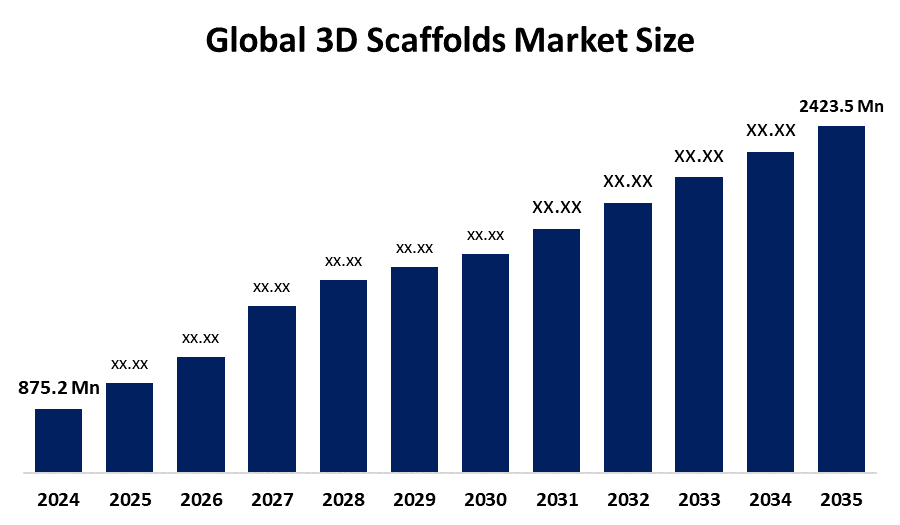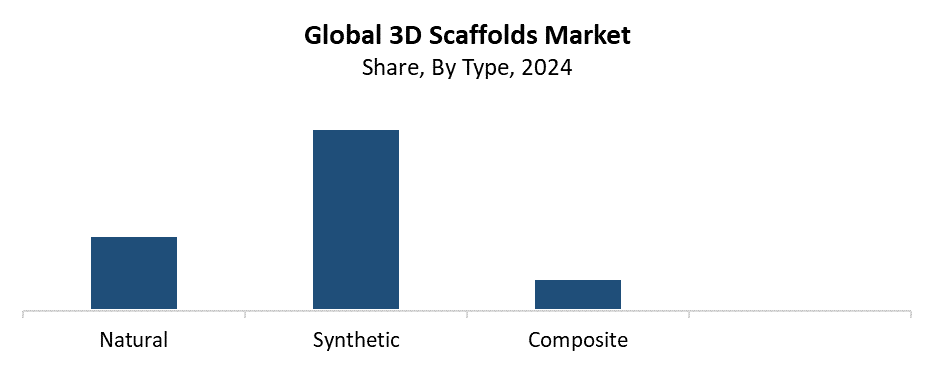3D Scaffolds Market Summary
The Global 3D Scaffolds Market Size Was Valued at USD 875.2 Million in 2024 and is Projected to Reach USD 2423.5 Million by 2035, Growing at a CAGR of 9.7% from 2025 to 2035. Growing need for tissue engineering, regenerative medicine, chronic illness prevalence, biomaterials, 3D printing, and expanding research and development in healthcare and biomedical applications are the main factors propelling the 3D scaffolds market.
Key Regional and Segment-Wise Insights
- In 2024, the North America 3D scaffolds market size held the largest revenue share of 36.82% and dominated the global market.
- In 2024, the synthetic segment held the highest revenue share of 63.27% and dominated the global market size by type.
- With the biggest revenue share of 42.73% in 2024, the tissue engineering and regenerative medicine segment led the worldwide 3D scaffolds market Size by application.
Global Market Forecast and Revenue Outlook
- 2024 Market Size: USD 875.2 Million
- 2035 Projected Market Size: USD 2423.5 Million
- CAGR (2025-2035): 9.7%
- North America: Largest market in 2024
- Asia Pacific: Fastest growing market

The 3D scaffolds market size consists of the development and use of three-dimensional structures which function as supportive frameworks for cell attachment and tissue growth and regeneration. These scaffolds serve multiple purposes in drug delivery systems, tissue engineering, and regenerative medicine for treating damaged tissues and organs through replacement or repair. The market receives its main support from growing organ transplantation alternatives, the expanding number of chronic illness patients, and increasing biomedical research funding. Scientists enhance scaffold performance through their work with biomaterials, which include hydrogels, ceramics, and biodegradable oils. The medical industry needs 3D scaffolds because patients require personalised treatment, and the population is growing older. Scientists have developed better regenerative therapies.
The field of scaffold design undergoes a complete transformation because of technological progress in 3D bioprinting, electrospinning, and nanofiber manufacturing, which enables precise control of mechanical properties, porosity, and structural design. The integration of stem cells with bioactive compounds in scaffolds generates better outcomes for tissue regeneration. The market receives support from governments and regulatory agencies through their financial backing of research projects and their implementation of rules. These promote biomedical technology development. Public-private partnerships, together with healthcare infrastructure enhancement programs, drive up research speed and clinical application rates, which in turn fuel worldwide growth of the 3D scaffolds market.
Type Insights

The synthetic segment led the 3D scaffolds market size with the largest revenue share of 63.27% in 2024. The widespread use of synthetic materials such as polymers, ceramics, and composites dominates because these materials offer superior mechanical strength and biocompatibility and customizable properties for tissue engineering applications. Synthetic scaffolds provide controlled breakdown rates and structural integrity, and enhanced consistency, which makes them suitable for various biomedical and regenerative medicine uses. The development and optimisation of synthetic scaffolds continues through ongoing research activities. These focus on the main manufacturing techniques such as electrospinning and 3D bioprinting. All of these elements work together to support the segment's dominant position in the global market for 3D scaffolds.
The natural segment of the 3D scaffolds market size will experience the fastest growth during the forecast period. Natural scaffolds provide superior biocompatibility, biodegradability, and support for cell adhesion and proliferation. The materials used to create them include collagen, chitosan, gelatin, and hyaluronic acid. These materials possess natural biological properties which make them perfect for tissue engineering and regenerative medicine applications that involve bone, cartilage, and skin repair. Biomedical research drives adoption through its need for materials which combine natural properties with environmental friendliness. Physiological activity drives adoption as well. The worldwide 3D scaffolds market experiences rapid growth because scientists now extract and purify materials better while developing improved scaffold construction techniques.
Application Insights
The tissue engineering and regenerative medicine segment led the 3D scaffolds market in 2024 with the largest revenue share of 42.73%. The leadership operates based on the rising demand for modern medical solutions, which substitute or fix damaged body parts because of accidents, prolonged illnesses, and birth defects. The development of new tissues and cell growth and differentiation depends heavily on 3D scaffolds, which serve as vital components for regenerative therapeutics. The market shows growth because scientific research activities have expanded, and three-dimensional bioprinting technology has advanced. Regenerative medicine has obtained increased funding. The worldwide use of 3D scaffolds market size for tissue engineering applications is increasing because patients want customised treatment approaches, and chronic diseases are becoming more common.
The drug discovery and toxicology screening segment of the 3D scaffolds market is expected to grow at a significant rate during the forecast period. 3D scaffolds provide cells with a more natural environment than 2D cultures, which enables better simulation of how drugs affect cells, how toxins work, and how tissues function. The process of drug development becomes faster and less expensive through improved preclinical testing methods, which produce more reliable results. The implementation of safer medications alongside high-throughput screening tools based on scaffold technology drives adoption in the market. The international growth of 3D scaffold applications in toxicology and drug discovery results from their combination with bioprinting technology and stem cell applications.
Regional Insights
The 3D scaffolds market is dominated by the North America region in 2024 by holding the largest revenue share of 36.82%. The region maintains its position as a leader because of its advanced healthcare facilities, well-known research centres, and extensive application of modern tissue engineering and regenerative medicine systems. The market growth results from substantial biomedical research funding, together with rising chronic disease rates and expanding requirements for organ transplantation and repair services. The United States and Canada lead the development of cutting-edge bioprinting technology, 3D scaffold materials, and regenerative medicines. The worldwide 3D scaffolds market has North America as its leader because the government supports tissue engineering research through funding programs. This includes academic-industrial collaborations.
Europe 3D Scaffolds Market Trends
The European market size for 3D scaffolds experienced significant growth in 2024 because of strong research activities and sophisticated healthcare systems, and the expanding use of tissue engineering and restoration medical solutions. Germany and the United Kingdom, together with France, lead the development and marketing of new scaffold materials through their work on synthetic and natural biomaterials. The market experiences growth because chronic diseases continue to spread while consumers learn more about regenerative therapies. Biomedical research receives increased funding from governments. Academic institutions, together with biotechnology companies and healthcare services, drive the advancement of 3D scaffold research through their collaborative partnerships. The combination of 3D bioprinting technology with electrospinning and nanofiber production methods results in better performance and wider distribution of 3D scaffolds throughout Europe.
Asia Pacific 3D Scaffolds Market Trends
The Asia Pacific 3D scaffolds market size is expected to grow at the fastest CAGR throughout the forecast period because healthcare infrastructure spending continues to rise, chronic diseases become more common, and advanced tissue engineering and regenerative medicine systems require more sophisticated solutions. 3D scaffold technologies have experienced rapid adoption in China, Japan, India, and South Korea because research activities have expanded and public understanding of regenerative medicine has grown. Governments have established policies that support biomedical innovation. The growing number of biotechnology firms, together with contract research organisations and multinational corporation partnerships, drives faster development and market introduction of new scaffold materials. The Asia Pacific market grows because of technological progress in natural biomaterials, nanofiber manufacturing, and 3D bioprinting technology.
Key 3D Scaffolds Companies:
The following are the leading companies in the 3D scaffolds market. These companies collectively hold the largest market share and dictate industry trends.
- Merck KGaA
- BellaSeno GmbH
- ReproCELL Inc.
- CellSystems
- Gelatex Technologies
- Ilex Life Sciences
- Thermo Fisher Scientific, Inc
- Femtika
- Ossiform
- Others
Recent Developments
- In August 2025, to aid in the recovery from spinal cord injuries, a research team from the University of Minnesota Twin Cities presented a novel method that integrated 3D printing, stem cell biology, and lab-grown tissues, according to a paper published in the peer-reviewed scientific journal Advanced Healthcare Materials.
- In December 2024, the Institute for Bioengineering of Catalonia's researchers created new 3D-printed scaffolds using calcium phosphate and polylactic acid. These novel scaffolds ensured better bone tissue repair and regeneration by encouraging the development of blood vessels.
Market Segment
This study forecasts revenue at global, regional, and country levels from 2020 to 2035. Decision Advisors has segmented the 3d scaffolds market based on the below-mentioned segments:
Global 3D Scaffolds Market, By Type
- Natural
- Synthetic
- Composite
Global 3D Scaffolds Market, By Application
- Tissue Engineering & Regenerative Medicine
- Stem Cell Research
- Cancer Research
- Drug Discovery & Toxicology Screening
- Others
Global 3D Scaffolds Market, By Regional Analysis
- North America
- Europe
- Germany
- UK
- France
- Italy
- Spain
- Russia
- Rest of Europe
- Asia Pacific
- China
- Japan
- India
- South Korea
- Australia
- Rest of Asia Pacific
- South America
- Brazil
- Argentina
- Rest of South America
- Middle East & Africa
- UAE
- Saudi Arabia
- Qatar
- South Africa
- Rest of the Middle East & Africa





